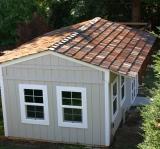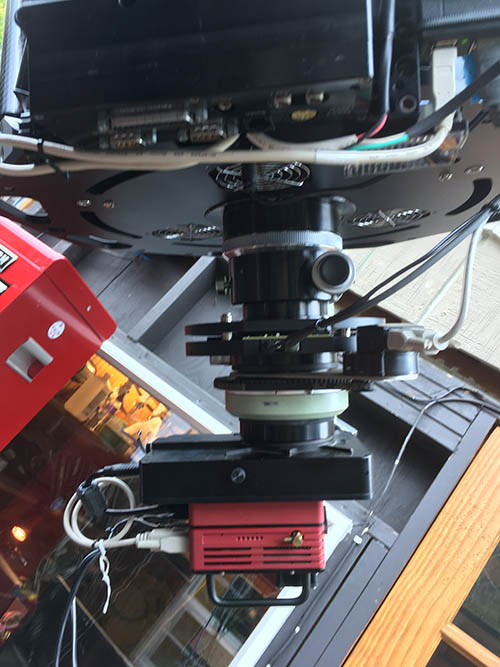
2020 Update: A Closeup of the RC 16 image train which includes the Finger Lakes Instruments PDF Focuser, an Astrodon Takometer Rotator, followed by a black off-axis guiding filter wheel and the red SBIG STT 8300 camera. Between each component are Precise Parts adapters-fitting each component to the next one in-line. I use the RC Focuser for "rough" focus and is locked in place, the FLI-PDF performs periodic precise focusing. |
|
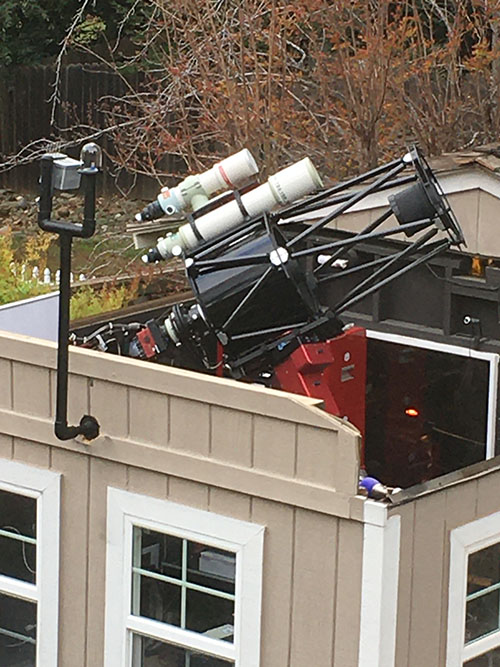
2020 Update: A new 16 inch Ritchey Chretien Telescope replaces the 12 inch Newtonian. Native focal length of the 16 RC is 3250 mm. Also shown is a new Sky Alert weather system. This system monitors weater conditions and can shutdown imaging session and close the roof for adverse weather conditions. The glass dome on top is a "cheapo all sky camera" made from a QHY 5M III camera and a 170 degree f2 lens from ZWO. Its perfect for visual sky conditions
|
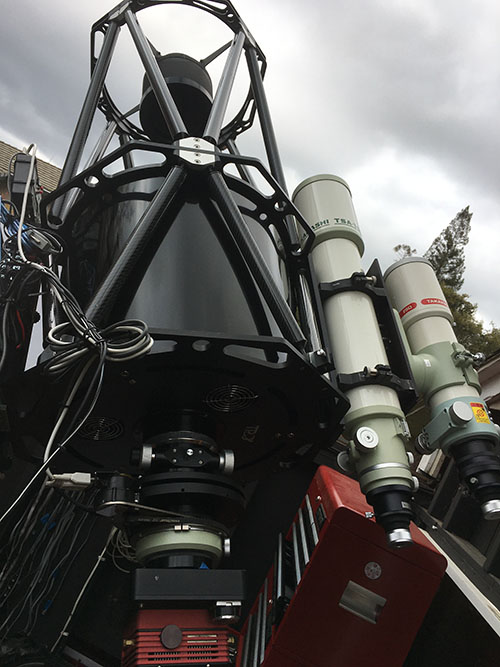
2020 Update: A closer look at the 16 inch Ritchey Chretien Telescope also showing the Takahashi TSA 102S (800 mm FL) and the Takahashi FSQ 85 (450 mm FL). With various Reducers/Extenders I can image a full range of astronomical sized objects. |
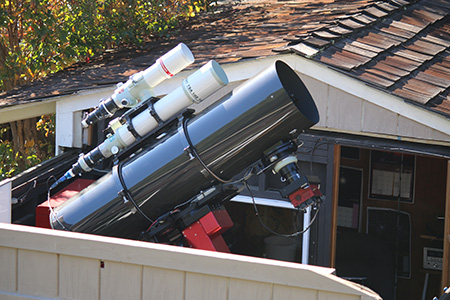
2019 Update: A newly mounted Takahashi FSQ-85 sits atop the Takahashi TSA-102s. Native focal length of the FSQ-85 is 450 mm. Using a reducer, the focal length is reduced to 325 mm. This wide field will be ideal for imaging large Nebula's
On the 12 in Newtonian, the image train includes the Finger Lakes Instruments PDF Focuser, an Astrodon Takometer Rotator, a 3 inch Adapter for the Televue "Big Paracorr" followed by an black off-axis guiding fIlter wheel and the red SBIG STT 8300 camera. Between each component are Precise Parts adapters-fitting each component to the next one in-line.
|
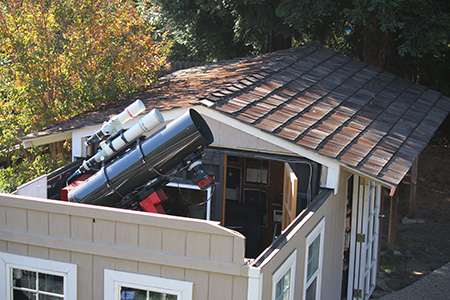
2019 Update: A picture of the setup from my outside deck. Looks like I need to trim some bushes
|
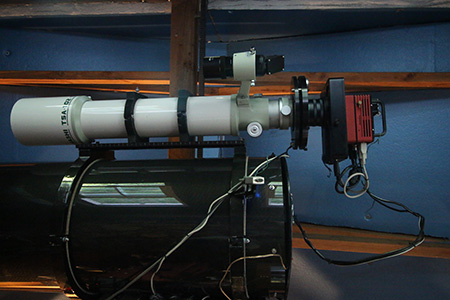
2019 Update: The Orion XT 12 was replaced with a Custom 12 in Newtonian. The 12 in, has a 4 inch diagonal mirror, suitable for largercamera imaging chips, a 14.5 inch carbon fiber tube, which drastically reduces the thermal shift during the night and thus reducing the refocusing required during the night. A new design triple fan base is bolted to the back. The Native focal length of the 12 inch is 1500 mm. However, common to Newtonian telescope, a coma corrector is required for imaging. I use a Televue "Big Paracorr" which increases the focal length to a measured 1825 mm.
On top, is the Takahashi TSA-102s fitted with a Finger Lakes Instruments PDF Focuser followed by a Takahashi Reducer (0.72x) and next is the off axis guided filter wheel (Black) and the SBIG STT 8300 CCD Camera (Red). I "roughly" manually set the focus using the TSA focuser, then during the night use the automated PDF focuser to refocus.
The STT8300-FW8G Camera replaced the ST2000XM/CFW10 camera in Dec 2012
|
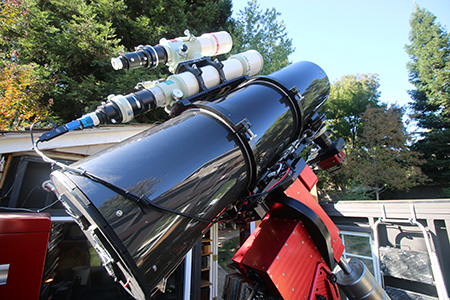
2019 Update: All three Telescopes are mounted to the Paramount ME. Here, Imaging is being done with the Custom 12 in Newtonian Telescope and I'm evaluating using the TSA-102s as a guide scope. The Blue Guiding camera is a QHY 5M video camera. It uses a dedicated USB 3.0 cable. Unfortunately, I found out my computer just cannot handle all the data streams; video, main camera, mount, planetarium software. Need to upgrade the computer next! The FSQ-85 sits waiting for an opportunity to image....
|

A newly mounted Orion XT-12, takes the place of the XT-10. The Orion XT-12's 12 inch mirror and diagonal was sent to Ostahowski Optics for optical testing prior to installation. Using double pass auto-collimation, the primary passed testing although "very slightly undercorrected". The diagonal tested to 1/8 wave using a Zygo interferometer. Three large and one small 12 VDC Fans were installed on the back, all switchable, to cool the mirror. Laminar flow is maintained inside the telescope at the smallest flow area, even with all fans operating. The Orion focuser was replaced with a Finger Lakes DF-2 digital focuser. To mate the camera to the focuser, special adapters were custom machined by Precise Parts . The Takahashi TSA 102S is installed piggyback on the XT-12. A SBIG ST2000 XM is installed with the CFW-10 and a new Optec Pyxis Camera Field Rotator . A Takahashi TOA reducer is also installed ahead of the rotator. Also shown are the cooling lines which carry refrigerator cooled water to the camera's CCD chip. |
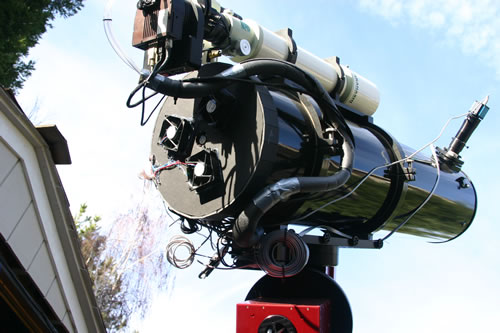
Mounted on the XT-12 is a new Imaging SourceUSB Video Camera. The camera model is the DBK 21AU04.AS containing a 1/4 inch CCD chip and shoots up to 60 frames per second. Using a Televue 4X Powermate , this camera is used for imaging the planets. Wire management has become quite a challenge with power cables, serial ports, a 7 multi-port USB hub filled to capacity. The number of lines going through the mount are minimized by use of the available Paramount Aux, Power and Lines using specially wired connectors. |
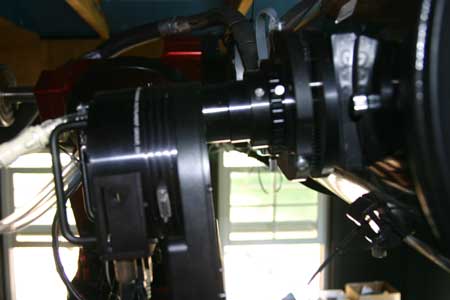
Backfocus is very limited on a Newtonian Telescope. Orion's stock focuser was removed and replaced with a curved machined adapter bolted directly to the telescope. Another adapter is located between the FLI DF-2 Focuser and the machined plate. A Televue Paracorr is mounted inside the DF-2 slip ring attachment and a T-Thread extension is used to place the Paracorr exactly 55mm from the ST-2000 CCD Camera imaging chip. |
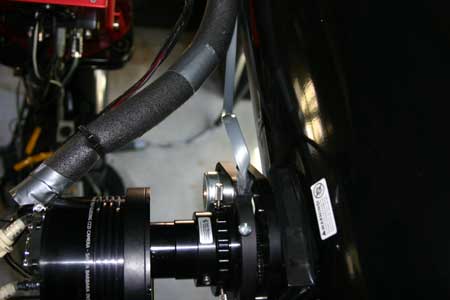
The ST-2000 was recently cleaned and upgraded at SBIG. It now contains the newer KAI 2020 chip, a remote guide port and back plate handles. Also seen is a 2 inch Scopetronix slip ring which allows easy rotation of the CCD camera without "significantly" disturbing focus distance and collimation. |
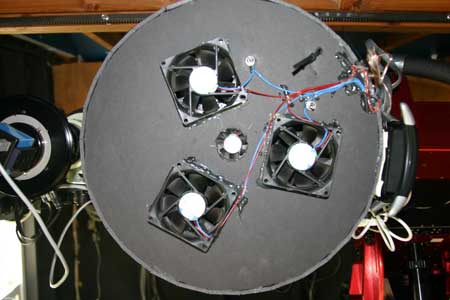
Three large and one small switchable cooling fans, installed on a removable foam board structure keep the 12 inch mirror near ambient temperature. |
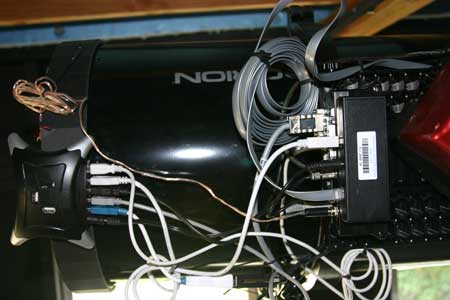
Someday I have to do something with this wiring mess. But it works! |
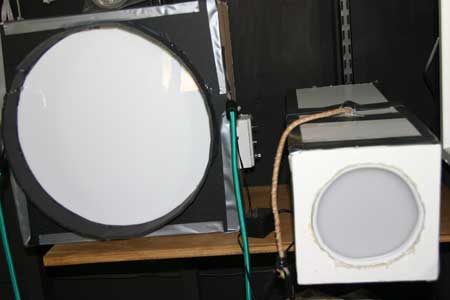
I use homemade light boxes for flats. One for the XT-12 and the other for the Takahashi TSA 102S. Both light boxes use LED's for light and two plexiglass screens for even illumination. |
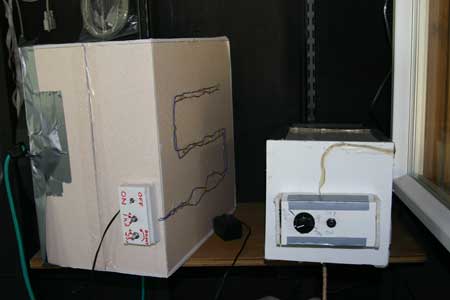
Both light boxes are dimmable to evenly illuminate the CCD sensor to the proper level. |
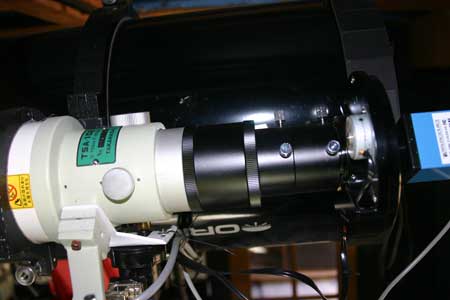
The TSA 102S Imaging configuration. For this photo, the Imaging Source webcam is installed. The Pyxis camera rotator is also shown. |
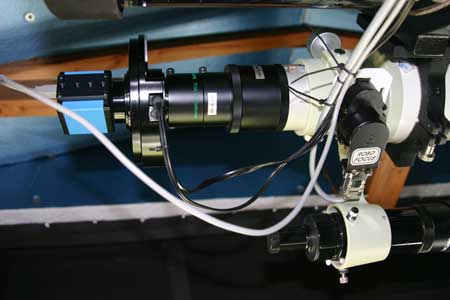 |
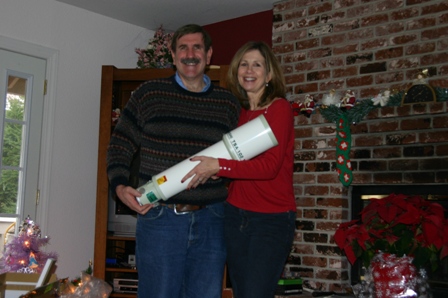
|
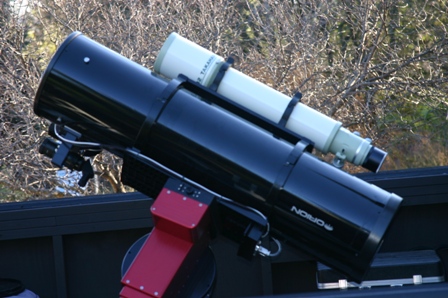 |
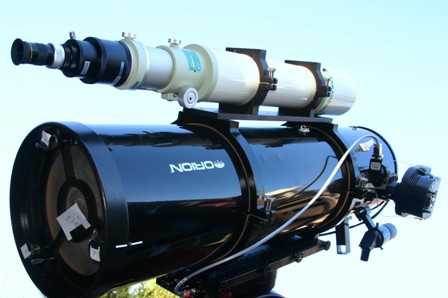
Newly Mounted Takahashi TSA 102S currently setup for visual astronomy. This High quality refractor has a 816mm focal length and a 102 mm aperature. It is an F8. For imaging it will be used with a TOA Flattener reducing the FOV to 800 mm and an F 7.84. The FOV can be further increased with a TOA Reducer changing the focal length to 610 mm at an F 5.98. The Focuser is in the process of being automated with a Robofocus motorized control unit operated by the computer (One focuser thumbwheel is missing). |
Imaging is performed with an Santa Barbara Instruments Group (SBIG) ST - 2000XM ccd camera. It contains the KAI 2001 imaging chip and a TC-237 autoguider. The camera has a chip size of 1600 X 1200 pixels. Combined with the XT-10 optics is has a resolution of 1.27 arc-seconds per pixel. Below the camera is the Color Filter Wheel CFW-10. It contains Clear, Luminance, Red, Green, Blue, Hydrogen alpha, Sulfer II and Oxygen III filters made by Astrodon. |
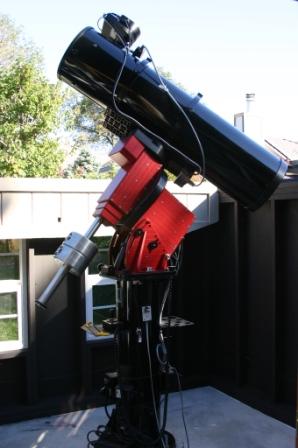
The Telescope is an Orion 10 inch Reflector (Newtonian). The aperature is 254 mm (10 inches) and it has a focal length of 1200 mm making it an F 4.7 instrument. It is fitted with a low profile JMI - DX2 Focuser, The Focuser is automated with a Robofocus motorized control unit operated by the computer. I have two Star Finders; an Orion 9x50 correct image finder and a Rigel Quickfinder for visual observance, but with the Paramount ME these are unnecessary. The Telescope is mounted on a New Paramount ME (July 2006) Robotic Telescope Mount. This mount accurately tracks objects across the sky and has very little periodic error. Since it is permanently mounted, polar alignment was achieved through a several hundred point mapping model across the viewable sky. TPoint is used to develop and execute the pointing model. Also new is the Le Sueur Astropier which supports the telescope and provides electrical (115VAC and 12VDC) and data, video, USB, Cat 5, serial port electrical outlets. Two shelves are also visible for eyepieces and other mount adjustment equipment. |
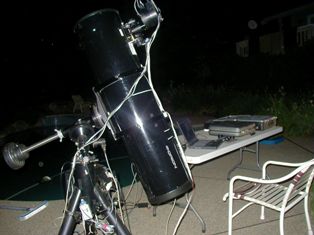
My Imaging Setup in 2003 and 2004. Camera is an ST-2000XM and the filter wheel is a CFW 8 and includes Luminance, Red, Green and Blue filters made by Custom Scientific.
|
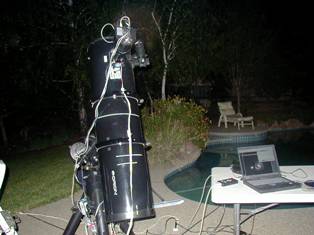
My Imaging Setup in 2003 and 2004. The Mount is a Losmandy G-11 with a Gemini Control System. Setup was a laborious process to polar align and adjust tracking. Imaging typically started on the third day of adjustment / tracking. |
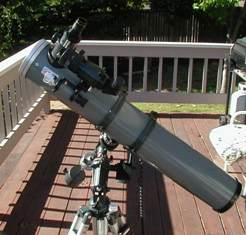
Meade 114EQ-DH4 Telescope. This autostar guided telescope performed remarkably well for it's $230 price. Equipped with a solar filter this picture is shown looking at the solar eclipse in June 2002. |
